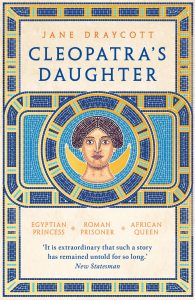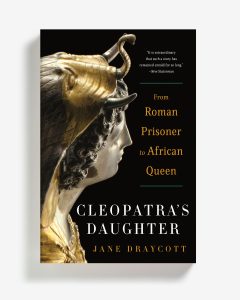Talking About Women’s History: Three Questions and an Answer with Jane Draycott
Jane Draycott is a Roman historian and archaeologist, and the author of Cleopatra’s Daughter: Egyptian Princess, Roman Prisoner, African Queen. Over the last two decades, she has worked in academic institutions in the UK and Italy, and excavated sites ranging from Bronze Age villages to First World War trenches across the UK and Europe. She is currently Lecturer in Ancient History at the University of Glasgow. When she is not reading, writing, or thinking about Roman history and archaeology, she enjoys indulging her wanderlust by travelling to interesting places, playing computer games, cooking vegan food, practising yoga, and hooping. She lives in Glasgow with a tyrannical Norwegian Forest Cat named Magnus, and is currently renovating a dilapidated Victorian house.
Take it away, Jane!
Cleopatra Selene was a powerful figure in her time, but was largely overlooked until your book. Why do you think Cleopatra Selene and other powerful women of the past effectively disappeared from history?
Cleopatra Selene and other powerful women of the past have effectively disappeared from history for several reasons. The first is that they were genuinely excluded from most of the formal political and military positions of power that were responsible for shaping world history, and the second is related to that – while they certainly had informal political and military power, the ancient authors recording events preferred not to acknowledge that unless it offered an opportunity to pass comment (usually negative) on the men they were connected to. So during the Late Roman Republic, Roman women could not hold magistracies or imperium, so could not speak in the Senate, vote on or enact legislation, or raise and command armies, but they could wield a considerable amount of influence behind the scenes, hosting social events, lobbying other well-placed women to intercede with their men-folk and so on. And the third is that (predominantly male) historians from later periods have taken the ancient literary evidence largely at face value, and not questioned the fact that women don’t tend to appear in it except in exceptional circumstances. It’s only in the last few decades that historians have started deliberately searching for, and finding, the women. And while not Roman, client queens like Cleopatra and Cleopatra Selene suffered from the fact that it was, in the main, Roman authors writing about them, so they were judged according to Roman standards, and Cleopatra is excoriated because of her husband and Cleopatra Selene is ignored in favour of her husband. Finally, for many modern historians, they baulk at the relatively slim Greek and Latin literary evidence, and it doesn’t necessarily occur to them to look for other types of evidence such as documentary and archaeological evidence to supplement that. Academics can often get quite uncomfortable about stepping outside of their somewhat arbitrary disciplinary boundaries.
What overlooked woman from the ancient world would you most like to read a biography of, and why?
I would love to read a biography of Queen Amanirenas of Kush. She was Cleopatra VII’s contemporary and next-door neighbour, but unlike Cleopatra she was able to fend off the emperor Augustus’ Roman legions and their imperialistic ambitions to seize her kingdom and turn it into a Roman province. She was a one-eyed warrior who led her army into Egypt, sacked many towns, pulled down all the statues of Augustus that had been set up, and even took the head of one home to Kush and buried it under the steps of the temple to the goddess Victory in the capital city of Meroe, so she and her fellow Kushites could walk on it until two thousand years later when archaeologists discovered and excavated it. This head is now on display in the British Museum, a permanent memorial to rare Roman military defeat, and one masterminded by a woman at that. She is a less well-known but much more successful version of Boudicca.
What work of women’s history have you read lately that you loved? (Or for that matter, what work of women’s history have you loved in any format? )
The best work of women’s history that I have read recently is Emma Southon’s A History of the Roman Empire in 21 Women. Brilliantly researched and written, simultaneously managing to be erudite, filthy, and funny. No one writes about the Romans quite like Emma.
[For anyone who missed it, a mini-interview with Emma Southon ran on March 6. The title in the U.S. is A Rome of One’s Own. I’m currently reading it and agree with everything Jane said about it.]
A question from Jane: Who is your favourite female historical figure, and why?
I never know how to chose when asked this kind of questions. There are are many historical women who I admire or who fascinated me. But the answer that will make my editor, my agent, my publicist, and My Own True Love happy is Sigrid Schultz, the subject of my book that is coming out in August. She really was quite a gal. She was the Chicago Tribune’s Berlin bureau chief from 1925 to 1941 and one of the first reporters to warn American readers about just how dangerous the Nazis were. She was smart, courageous, and equal parts charming and prickly.
Now that I think about it, most of my favorite women in history could be described in similar terms.
***
Want to know more about Jane Draycott and her work?
Visit her website: https://drjanedraycott.co.uk/
Follow her on the platform previously known as Twitter: @JLDraycott
Follow her on Instagram: jane.draycott.
***
Come back tomorrow for three questions and an answer with Carolyn Whitzman, author of Clara at the Door with a Revolver: The Scandalous Black Suspect, the Exemplary White Son, and the Murder That Shocked Toronto







